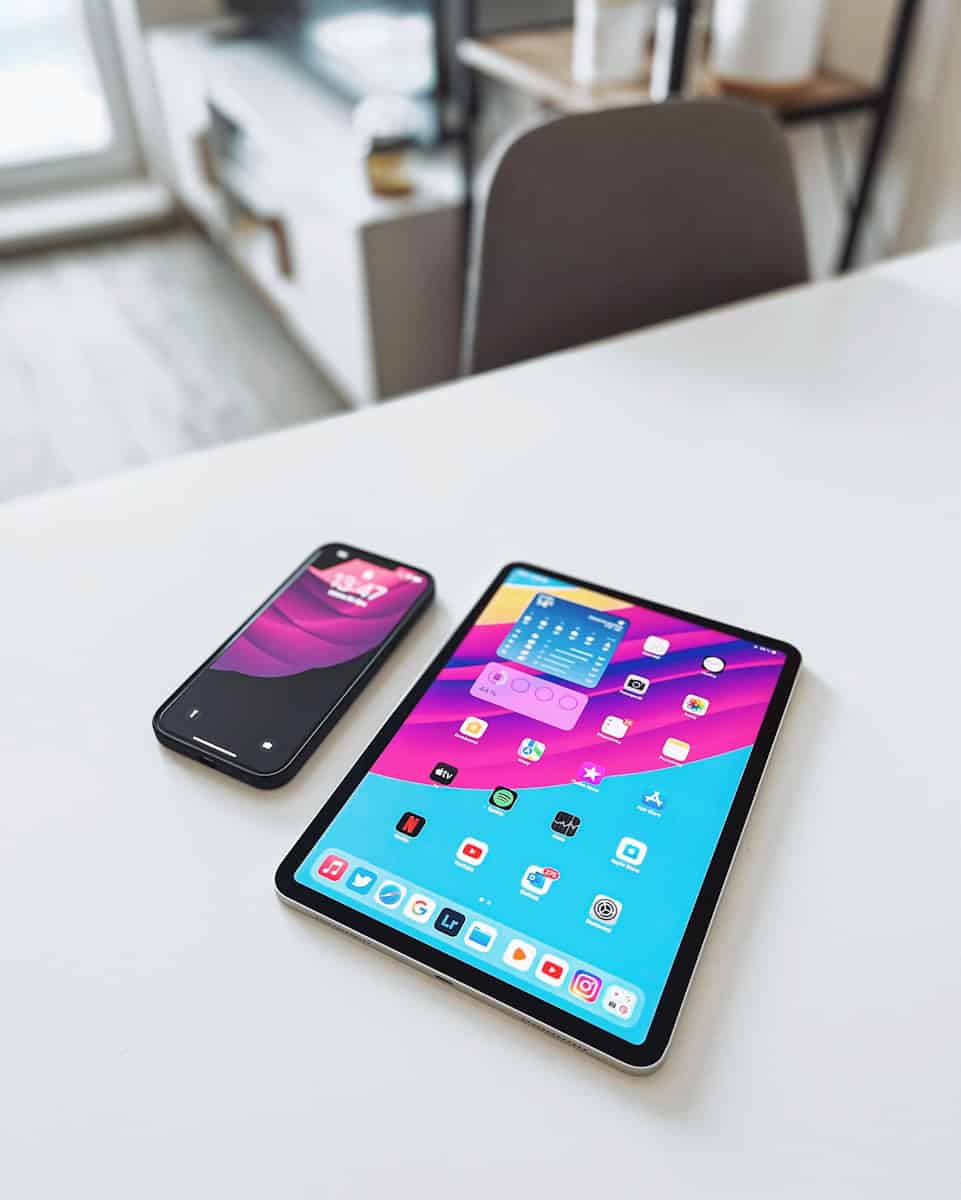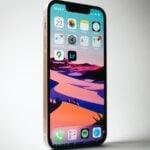Having your photos show up across all your Apple devices can be handy, but it can also be annoying when you want to keep some pictures private or separate. Maybe you want to stop your work iPad from showing personal photos, or perhaps you’re sharing an Apple ID but need separate photo libraries. To stop sharing photos between your iPhone and iPad, you need to turn off iCloud Photos on the device where you don’t want the photos to appear by going to Settings > Your Name > iCloud > Photos and toggling off “Sync this iPad” or “iCloud Photos.”
This simple setting change prevents new photos from syncing between your devices while keeping your existing setup intact. Each device can have its own photo collection without affecting the others. You might want this separation for many reasons – perhaps to save storage space on certain devices or to keep work and personal images completely separate.
Turning off photo sharing doesn’t mean losing your photos. They’ll stay on the original device where they were taken or saved. And if you ever change your mind, you can always turn the sync back on and reconnect your photo libraries across your Apple gadgets.
Here are the steps to stop sharing photos between your iPhone and other Apple devices like an iPad, Mac, or another iPhone:
1. Turn Off iCloud Photos
This prevents photos from syncing across all devices using the same Apple ID.
- Open the Settings app on your iPhone.
- Tap [your name] at the top.
- Tap iCloud > Photos.
- Toggle off Sync this iPhone (or iCloud Photos on older versions).
Do the same on your iPad, Mac, or any other device to stop syncing photos entirely.
2. Disable Shared Albums (if used)
Shared Albums let you share specific photos with others or between your devices.
- Go to Settings > Photos.
- Scroll down and toggle off Shared Albums.
3. Sign Out of iCloud (if you want full separation)
If you want complete separation between devices:
- Go to Settings > [your name] > Sign Out.
- You’ll be prompted to choose what data to keep on your device.
- This removes iCloud syncing across the board, including photos, messages, and contacts.
4. On Mac: Turn Off iCloud Photos
- Open System Settings or System Preferences.
- Click Apple ID > iCloud > Photos.
- Toggle off iCloud Photos.
5. Delete Synced Photos If Needed
After turning off syncing, photos may still be on your device. You can delete them manually without affecting other devices (as long as iCloud Photos is off).
By following these steps, you can prevent your photos from automatically appearing across all Apple devices linked to the same account.
Key Takeaways
- Turn off iCloud Photos on specific devices to stop automatic photo sharing across your Apple products.
- Photos already on your devices will remain there even after turning off syncing.
- Each Apple device can have its own separate photo library while still using the same Apple ID for other services.
Understanding iCloud and Apple ID
When using Apple devices, iCloud and your Apple ID control how photos move between your devices. These two systems work together to sync your data across iPhone, iPad, and Mac.
The Role of iCloud in Data Sharing
iCloud is Apple’s cloud storage service that keeps your photos, documents, and other data in sync across devices. When you take a photo on your iPhone, iCloud can automatically upload it and make it available on your iPad or Mac.
The main function of iCloud Photos is to create a complete library that’s accessible from any device. This happens when the iCloud Photos feature is turned on in your settings.
iCloud gives you 5GB of free storage, but this fills up quickly with photos. You can see how much storage you’re using in Settings > Your Name > iCloud.
To stop photo sharing between devices, you need to:
- Go to Settings
- Tap your name (Apple ID)
- Select iCloud
- Tap Photos
- Turn off “Sync this iPad” or “iCloud Photos”
Apple ID: The Core of Your Apple Ecosystem
Your Apple ID connects all your devices and services together. It’s the login you use for the App Store, iCloud, iMessage, and more.
When multiple devices use the same Apple ID, they’re treated as belonging to the same person. This is why photos automatically sync across devices with the same Apple ID.
If you want separate photo libraries, you have two options:
- Use different Apple IDs for each device
- Turn off iCloud Photos on specific devices
Family Sharing lets up to six family members share purchases while keeping personal data private. Each person uses their own Apple ID but can share App Store purchases, an iCloud storage plan, and more.
How iCloud Photos Sync Works
iCloud Photos connects all your Apple devices so your pictures appear everywhere. This service keeps your photo library consistent across your iPhone, iPad, and Mac while offering storage options to save space on your devices.
iCloud Photos on iPhone, iPad, and Mac
When you turn on iCloud Photos in your settings, all your photos and videos upload to your iCloud account. This happens automatically when your device connects to Wi-Fi.
Once uploaded, these images appear on all your Apple devices signed into the same Apple ID. Take a photo on your iPhone, and it shows up on your iPad moments later.
To manage this feature:
- Go to Settings > Your Apple ID > iCloud > Photos
- Toggle iCloud Photos on or off
If you want to stop sharing photos between devices, you must turn off this sync feature on each device individually. When disabled, new photos taken on that device stay only on that device.
Some users prefer keeping separate photo collections on different devices. This requires turning off the sync option in iCloud settings.
Optimize iPhone Storage Vs. Download and Keep Originals
iCloud Photos offers two storage options to help manage space on your devices.
Optimize iPhone Storage: This option keeps small, low-resolution versions of photos on your device while storing full-quality originals in iCloud. Your phone downloads the full version only when you view or edit a photo.
This setting is perfect for devices with limited storage. Your photo library can be much larger than your device’s physical storage capacity.
Download and Keep Originals: This option stores full-resolution photos and videos on your device. Everything stays at maximum quality but takes up more space.
To choose between these options:
- Go to Settings > Your Name > iCloud > Photos
- Select either “Optimize iPhone Storage” or “Download and Keep Originals”
The option works independently on each device. Your iPad could optimize storage while your Mac keeps originals for editing.
How to Disable iCloud Photos
If you want to keep your photos private on each device, turning off iCloud Photos is the way to go. This process varies slightly depending on whether you’re using an iPhone, iPad, Mac, or Windows PC.
Turn Off iCloud Photos on iPhone and iPad
To stop sharing photos between your iPhone and iPad, you need to disable iCloud Photos on each device.
First, open the Settings app on your device. Tap on your name or Apple ID at the top of the screen. Then select iCloud from the menu options.
Next, tap on Photos to access photo syncing settings. You’ll see a toggle switch next to “Sync this iPad” or “iCloud Photos”. Simply slide this toggle to the OFF position.
Once disabled, your photos will no longer automatically sync between your devices. New photos taken on your iPhone won’t appear on your iPad, and vice versa.
Be aware that turning off iCloud Photos might ask if you want to keep previously downloaded photos on your device. Choose the option that best fits your needs.
Disable iCloud Photos on a Mac
Turning off photo sharing on your Mac follows a different process than on iOS devices.
Open the Photos app on your Mac. Click on Photos in the menu bar at the top of the screen, then select Preferences (or Settings in newer macOS versions).
In the preferences window, click on the iCloud tab. Uncheck the box next to iCloud Photos to disable the feature.
Your Mac will ask what you want to do with photos already downloaded to your computer. You can choose to Download Originals to keep all photos on your Mac, or select Remove from Mac if you want to free up storage space.
After turning off iCloud Photos, your Mac will stop syncing with your other Apple devices. Changes made to your photo library on one device won’t affect others.
Turning Off iCloud Photos on Windows PC and iCloud for Windows
If you use a Windows PC, you can also stop photo syncing through iCloud for Windows.
First, download and install iCloud for Windows from the Microsoft Store if you haven’t already. Open the app after installation.
Sign in with your Apple ID and password. Once signed in, you’ll see various iCloud services listed. Uncheck the box next to Photos to disable photo syncing.
Click Apply to save your changes. This will stop your Windows PC from downloading photos from your iCloud account or uploading new ones.
If you want to keep a copy of your photos, make sure to back them up before turning off iCloud Photos. Your photos will remain in iCloud storage until you delete them manually.
Managing Linked Devices and Accounts
When you want to stop photo sharing, you often need to manage how your devices connect to each other. This includes unlinking devices, removing Apple IDs, and handling your iCloud storage settings properly.
Unlink iPhones and iPads
To unlink iPhones with the same Apple ID, start by opening the Settings app on your device. Tap on your Apple ID at the top of the screen.
Next, select “iCloud” and then “Photos.” You’ll see a toggle switch next to “Sync this iPad” or “iCloud Photos.” Turn this off to stop sharing photos between devices.
For a complete separation between devices:
- Go to Settings > Your Name > iCloud
- Scroll down to find “Photos”
- Toggle off “iCloud Photos”
This prevents automatic syncing of your photo library across your Apple devices. Your existing photos will remain on each device, but new pictures won’t transfer automatically.
Remove an Apple ID from a Device
Sometimes you need to completely remove an Apple ID from a device. This is useful when:
- Selling your device
- Giving it to someone else
- Setting up a separate photo library
To remove an Apple ID:
- Open Settings
- Tap your name at the top
- Scroll down and select “Sign Out”
- Enter your password when prompted
- Choose which data to keep on the device
When you sign out, you can decide if you want to keep copies of certain data on the device. For photos, you might want to keep a copy before signing out with a new Apple ID.
Managing iCloud Devices and Account Storage
Your iCloud storage affects how photos sync between devices. To manage connected devices and storage:
- Go to Settings > Your Name
- Scroll down to see all linked devices
- Tap any device to see details or remove it
- Go to Settings > Your Name > iCloud
- Tap “Manage Storage”
Photos often use the most storage. You can free up space by:
- Turning off “iCloud Photos”
- Using “Optimize iPhone Storage” option
- Deleting large videos or screenshots
If you don’t want data syncing between specific devices, you can also manage which apps use iCloud on each device individually. This gives you more control over what syncs where.
Restoring Devices Without Merging Content
When you restore an Apple device, you might end up with duplicate photos across devices. The right setup can prevent this frustrating issue and keep your photo libraries separate.
Restore iPad from iPhone Backup Correctly
Restoring an iPad from an iPhone backup can cause unwanted photo merging. To avoid this, use a clean setup approach instead of a full backup restoration.
Start by turning off iCloud Photos on your iPhone before creating the backup. Go to Settings > [your name] > iCloud > Photos and toggle off “iCloud Photos.”
Next, when setting up the iPad, choose “Set Up as New iPad” instead of “Restore from Backup.” This creates a fresh start without inheriting photo libraries.
If you need specific content, use phone transfer apps that let you select exactly what to move. These apps allow you to transfer contacts and messages without photos.
Remember to keep iCloud Photos disabled on the new device until you’ve confirmed your settings are correct.
Preventing Automated iCloud Sync of Photos During Restoration
iCloud tries to be helpful by automatically syncing photos during device setup. This “helpfulness” often causes unwanted photo sharing.
Before restoration, sign out of iCloud on the source device. Go to Settings > [your name] > Sign Out. This prevents automatic syncing during the setup process.
When you reach the Apple ID setup screen on your new device, select “Skip this step” or “Set up later.” You can always add your Apple ID after confirming your photo settings.
After setup, go to Settings > Photos and make sure iCloud Photos is turned off before signing back into iCloud.
For extra protection, enable “Download and Keep Originals” instead of “Optimize Storage” if you do use iCloud Photos later. This setting gives you more control over what’s stored where.
Using Other Services and Features
While iCloud offers seamless photo sharing, there are other solutions that give you more control over what photos appear across your devices. These alternatives can help you keep certain images private or manage how your devices interact.
Alternatives to iCloud Photos
If you want to stop automatic photo sharing between Apple devices, you might consider other storage options. Google Photos lets you choose which devices upload images, giving you better control. You can install it on just one device to keep photos separate.
Dropbox offers similar flexibility with selective sync features. You can create separate folders for different devices and only sync what you choose.
For local transfers without cloud services, try AirDrop for one-time sharing. It lets you send specific photos without creating ongoing shared libraries.
iTunes can also help manage photos. Connect your device to a computer, select it in iTunes, and manually sync only the photos you want to each device.
Understanding Handoff and Continuity Features
Apple’s Handoff feature can sometimes cause confusion with photo sharing. This feature lets you start a task on one device and finish on another. To control this:
- Go to Settings > General > AirPlay & Handoff
- Toggle “Handoff” off to prevent automatic activity sharing
Continuity features also affect how your devices interact. If you don’t want your iPad picking up photo edits from your iPhone, turn off Handoff.
The Find My app uses location sharing that might reveal photo locations. To stop this, go to Settings > [Your Name] > Find My and turn off “Share My Location” to keep photo location data private.
Guidelines for Private Pictures and Sensitive Data
For truly private photos, use the Hidden album feature in Photos app. To hide photos:
- Select images
- Tap the share icon
- Scroll down and tap “Hide”
These photos won’t appear in your regular albums. For extra security, lock the Hidden album by going to Settings > Photos and toggling on “Use Face ID/Touch ID.”
Consider using third-party apps like “Private Photo Vault” which offer password protection and encryption for sensitive images.
Remember to regularly audit shared albums. Check your Shared Albums section in Photos app to see what you’re sharing and with whom.
For work documents containing sensitive data, use dedicated apps like Files with password protection rather than keeping them in Photos.
Best Practices for Maintaining Separate Devices
When using multiple Apple devices, you can keep your photos and other data separate with the right settings. This gives you more control and helps protect your privacy across your iPhone, iPad, and Mac.
Data Management Without iCloud Photos Sync
To keep different photos on each device, you’ll need to turn off iCloud Photos on the devices where you want separate photo libraries. Go to Settings > (your name) > iCloud > Photos and toggle off iCloud Photos.
For devices where you’ve already turned off sync, you’ll need to decide what to do with existing photos. You can:
- Delete unwanted photos from individual devices
- Keep local copies without cloud backup
- Use alternative backup methods like computer transfers
Remember that after turning off iCloud Photos, new pictures taken on one device will stay only on that device. You’ll need to manually transfer photos if you later want them on multiple devices.
Many users find that disabling iCloud Photos works best when they want completely different photo libraries on each device.
Tips for Non-Photo Data Sharing Between Devices
Even with separate photo libraries, you might still want to share other data between devices. Here’s how to manage this balance:
Selective iCloud Services
- Keep contacts, calendars, and notes synced while photos remain separate
- Use iCloud Drive for document sharing without photo sync
- Turn on Messages in iCloud for conversation history across devices
Alternative Sharing Methods:
- AirDrop for quick file transfers between nearby devices
- Email or messaging apps for sending specific files
- Third-party cloud services like Dropbox or Google Drive
These options let you maintain device independence while still enjoying the convenience of sharing important information. Users can customize their sharing setup based on their specific needs and privacy concerns.
Maintaining Privacy Across Multiple Devices
Privacy management becomes important when using multiple Apple devices. Start by turning off Share My Location in the Find My app if you don’t want location sharing between devices.
For shared albums in Photos, review and remove any you no longer want to share. Go to the Albums tab, select Shared Albums, and manage your sharing settings.
Other privacy tips include:
- Setting up different Apple IDs for different devices (extreme separation)
- Using Screen Time passcodes to prevent unauthorized access
- Regularly reviewing which apps have permission to access photos
- Using Face ID or Touch ID on all devices
Family members often benefit from these separation techniques when sharing devices. Parents might want personal photos only on their iPhone while keeping family photos accessible on a shared iPad.
Stopping photo sharing between devices gives users more control over their personal media and helps maintain privacy boundaries in various situations.
Frequently Asked Questions
Managing photo sharing between Apple devices can be tricky. These common questions address how to stop unwanted photo syncing and create separate photo libraries across your devices.
What steps can be taken to disable iCloud Photo Sharing across different devices?
To disable iCloud Photo Sharing across your devices, you need to access your device settings. On your iPhone or iPad, go to Settings and tap on your Apple ID at the top.
Select iCloud, then Photos. Turn off the iCloud Photos option to stop automatic syncing. This prevents new photos taken on one device from appearing on others.
On a Mac, go to System Preferences (or System Settings), click on your Apple ID, select iCloud, and uncheck Photos. These steps ensure photos stay only on the device where they were taken.
What is the process to dissociate photo sync between iPhones under a single Apple ID?
When multiple iPhones use the same Apple ID, photos typically sync automatically. To stop this, you can use separate photo libraries.
One effective method is to enable separate iCloud accounts for different devices while maintaining the same Apple ID for other services. Create a secondary iCloud account and use it exclusively for photos on one device.
You can also turn off iCloud Photos on specific devices. On the iPhone you want to keep separate, go to Settings > Apple ID > iCloud > Photos and toggle off iCloud Photos.
How can individual devices be set to prevent automatic photo sharing in a shared Apple ecosystem?
In a shared Apple ecosystem, each device can be set up with its own photo preferences. Start by accessing the Photos settings on each device.
On an iPhone or iPad you want to keep private, go to Settings > Photos and turn off Shared Albums. This stops that specific device from participating in photo sharing.
You can also disable location sharing by going to Settings > Privacy > Location Services > Share My Location and turning it off. This helps maintain privacy for individual devices in a shared ecosystem.
Is there a way to selectively stop photo streams from syncing between an iPhone and an iPad?
Yes, you can selectively control which photo streams sync between devices. One option is to use Shared Albums with specific permissions.
Create separate Shared Albums for different purposes and only invite certain devices. On your iPhone or iPad, open the Photos app, go to the Shared Albums tab, and manage permissions for each album.
You can also use the My Photo Stream feature selectively. This uploads only your most recent photos and doesn’t store them permanently in iCloud, giving you more control over what syncs.
What measures can be implemented to maintain separate photo libraries on each Apple device?
Maintaining separate photo libraries requires disconnecting devices from unified cloud storage. The most direct approach is turning off iCloud Photos on devices where you want independent libraries.
Another option is using different Apple IDs for different devices. This creates completely separate ecosystems, though it limits other sharing features.
You can also use local storage options instead of cloud services. Connect your device to a computer and back up photos manually, then delete them from the device to prevent them from syncing.
How can I disable the feature that shares photos to all of my devices when using the same Apple ID?
When using the same Apple ID across devices, you can still stop automatic photo sharing. Go to Settings > your Apple ID > iCloud > Photos on each device.
Turn off “iCloud Photos” to prevent automatic syncing. This keeps new photos on the original device only and stops them from appearing elsewhere.
For more control, you can also disable Shared Albums and My Photo Stream in the same menu. These options give you the convenience of a single Apple ID while maintaining separate photo collections on each device.







